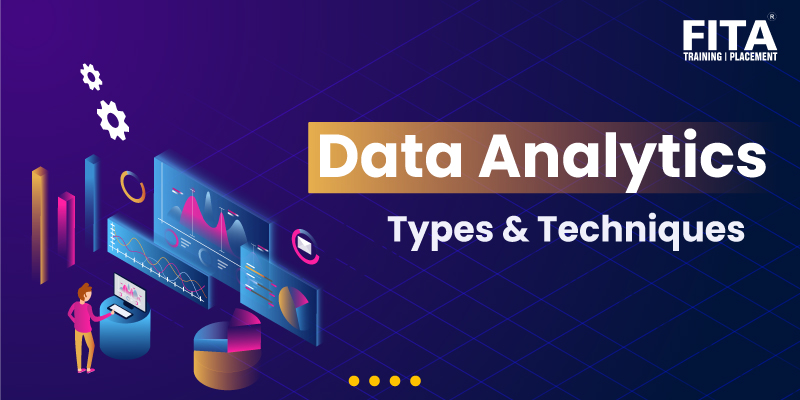
Data analytics is the scientific discipline dedicated to scrutinizing raw data with the aim of drawing insightful conclusions about information. Numerous techniques and procedures within the realm of data analytics have been mechanized through the implementation of algorithms and mechanical processes. These automated processes operate on raw data, ultimately delivering results that are comprehensible and applicable for human consumption. For individuals seeking to enhance their skill in this field, exploring a reputable Data Analysis Course in Chennai could provide valuable insights and hands-on experience.
Understanding Data Analytics
Data analytics is an extensive term encompassing diverse forms of data analysis. It involves subjecting any type of information to analytical techniques to derive insights that contribute to improvement. By revealing trends and metrics that might otherwise remain obscured within vast datasets, data analytics enables the optimization of processes, thereby enhancing the overall efficiency of businesses or systems.
For instance, manufacturing companies routinely capture runtime, downtime, and work queue data for various machines, subsequently analyzing this information to refine workloads and ensure machines operate closer to peak capacity.
Beyond identifying production bottlenecks, data analytics plays a pivotal role in various sectors like data science. In the gaming industry, it helps set reward schedules for players, maintaining engagement levels. Similarly, content companies leverage data analytics to optimize user interactions, whether through enticing clicks, prolonged watching, or strategic content reorganization to generate additional views.
The significance of data analytics lie-down in its ability to empower businesses to optimize performance. Integration into the business model allows companies to identify more efficient operational methods and efficiently manage vast amounts of data, leading to cost reduction and overall business enhancement.
Data Analysis Steps
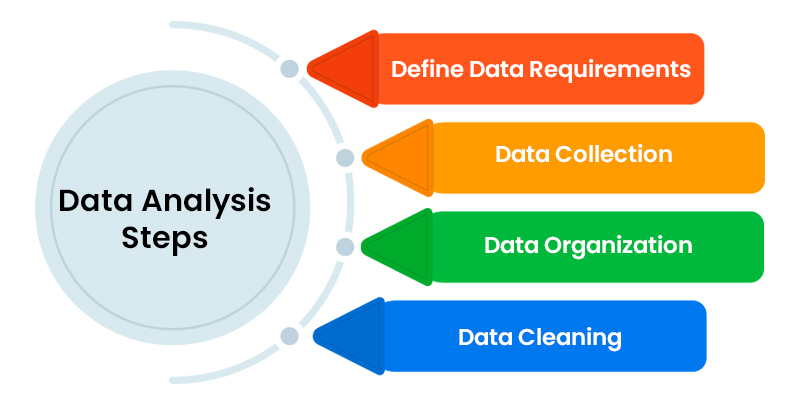
The data analysis process encompasses several sequential steps:
Define Data Requirements
Identify how data is categorized, whether by age, demographic, income, gender, or other factors. Distinguish between numerical data values and categorical data.
Data Collection
Gather data from various sources, including computers, online platforms, cameras, environmental sensors, or through human resources.
Data Organization
Organize collected data for analysis, utilizing tools such as spreadsheets or other software capable of handling statistical data.
Data Cleaning
Scrutinize and refine the data to eliminate duplication, errors, or incompleteness.
Ensure data integrity and accuracy before forwarding it to a data analyst for further analysis.
By following these steps, the data analysis process establishes a systematic approach to handling and preparing data for insightful interpretation and decision-making.
Types of Data Analytics
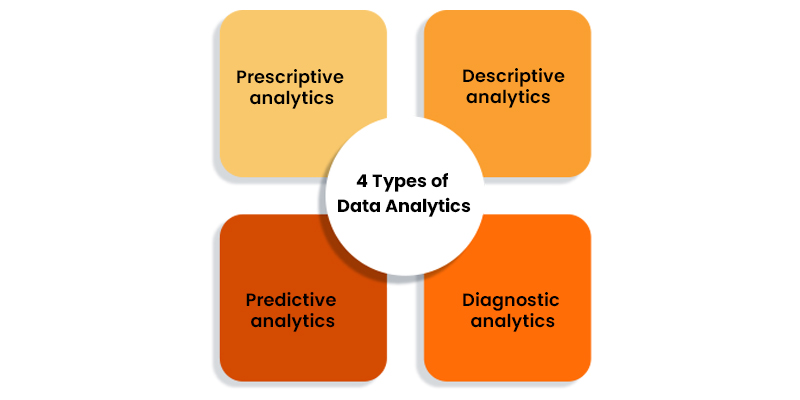
Data analytics can be categorized into four fundamental types, each serving distinct purposes:
Descriptive Analytics
Describes past occurrences over a specified timeframe.
Example: Analyzing whether the number of views has increased or if sales are stronger compared to the previous month.
Diagnostic Analytics
Focuses on understanding the reasons behind events and Involves diverse data inputs and hypothesis development.
Example: Investigating if weather conditions impacted beer sales or assessing the influence of a recent marketing campaign on sales.
Predictive Analytics
Forecasts likely future events in the near term and Utilizes historical data to predict outcomes.
Example: Projecting sales based on past performance during hot summers or using weather models to predict the likelihood of a warm season.
Prescriptive Analytics
Recommends a course of action based on analysis.
Example: Proposing the addition of an evening shift and renting an additional tank for increased output if the probability of a hot summer, derived from multiple weather models, exceeds a specified threshold.
Data analytics is integral to quality control systems in various sectors, including finance with programs like Six Sigma. Optimization is challenging without accurate measurements, whether it involves monitoring weight or defects in a production line.
Industries such as travel and hospitality leverage data analytics for quick turnarounds, identifying and resolving customer-related issues. In healthcare, large volumes of structured and unstructured data inform rapid decision-making. Similarly, the retail sector uses extensive data analysis to understand trends, recommend products, and enhance profitability. For individuals aspiring to delve into the dynamic field of data analytics, considering a specialized Data Analysis Course in Bangalore could be a strategic step towards gaining practical skills and staying abreast of industry demands.
Data Analytics Techniques
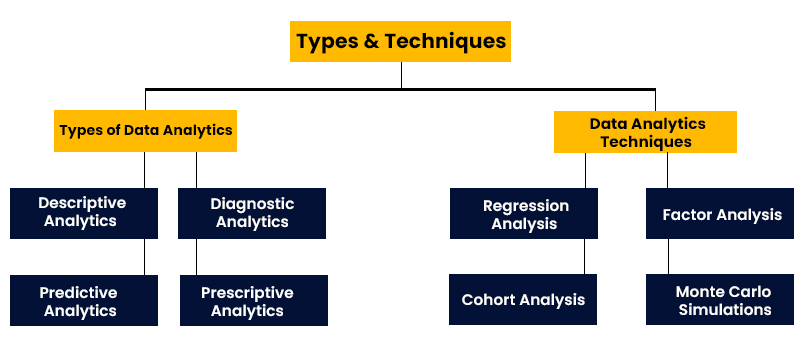
Data analysts employ various analytical methods and techniques to process and derive insights from data. Some prominent methods include:
Regression Analysis
Analyzing the relationship between dependent variables to understand how changes in one variable will impact another.
Factor Analysis
Condensing a large dataset into a smaller set to uncover hidden trends that might be challenging to discern in the original data.
Cohort Analysis
Breaking down a dataset into groups of similar data, often based on customer demographics. This allows for a detailed examination of specific subsets of data.
Monte Carlo Simulations
Modelling the probability of various outcomes, commonly used for risk mitigation and loss prevention. These simulations incorporate multiple values and variables, offering enhanced forecasting capabilities.
Time Series Analysis
Tracking data over time to establish the relationship between the value of a data point and its occurrence. This technique is useful for identifying cyclical trends or projecting financial forecasts.
These analytical methods empower data analysts to uncover patterns, relationships, and trends within datasets, enabling informed decision-making and strategic planning.
Data Analytics Tools
The field of data analytics has undergone rapid technological advancements, coupled with an extensive array of mathematical and statistical methodologies for data analysis. Data analysts leverage a diverse set of software tools to facilitate data acquisition, storage, processing, and reporting of findings.
Traditionally, data analytics has been associated with spreadsheets and Microsoft Excel, with analysts frequently utilizing raw programming languages for the transformation and manipulation of databases.
For reporting and communicating findings, data analysts benefit from specialized tools such as Tableau and Power BI. These data visualization and analysis platforms enable the compilation of information, performance of data analytics, and dissemination of results through interactive dashboards and reports.
Moreover, emerging tools contribute to the toolkit of data analysts. SAS serves as an analytics platform supporting data mining, while Apache Spark, an open-source platform, proves valuable for processing large datasets. With a diverse range of technological capabilities at their disposal, data analysts continually enhance the value they deliver to their organizations.
If you want to know more about the latest salary trends for data scientists, Check out Data Scientist Salary For Freshers, which will help you get an insight into the job packages as per the companies, skills and experience.
Role of Data Analytics
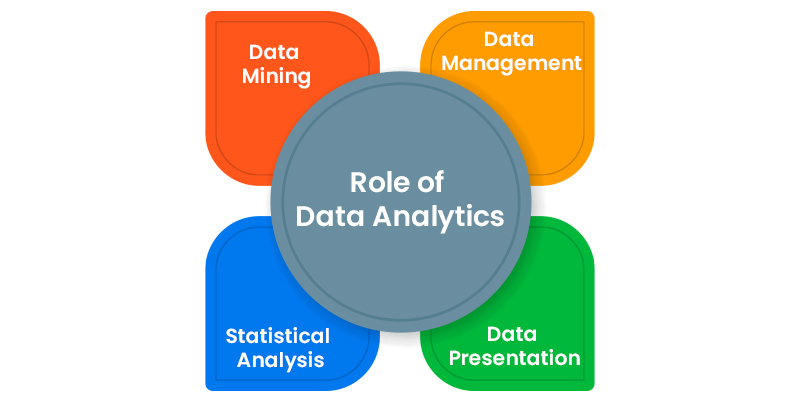
Data analytics plays a vitral role in enhancing operations, efficiency, and performance across various industries by uncovering valuable patterns. The adoption of these techniques provides companies and businesses with a competitive edge. The data analytics process involves four fundamental steps:
Data Mining
This initial step involves gathering data from diverse sources, often referred to as “mining.” Various types of information are collected and standardized into a consistent format for subsequent analysis. While this process may be time-intensive, it lays the foundation for meaningful insights.
Data Management
Once data is collected, it needs to be organized and stored in a database for efficient management and accessibility. The creation of a database is crucial to store and retrieve information. SQL (Structured Query Language), developed in 1979, remains a widely used tool for querying relational databases and facilitating easier analysis of resulting datasets.
Statistical Analysis
The third step involves statistical analysis, where the gathered and stored data is interpreted to create models that reveal trends. Open-source programming languages, such as Python for data analysis, are commonly employed for this purpose. Specific tools like R can also be utilized for statistical analysis or graphical modeling.
Data Presentation
The final step revolves around presenting the results of the data analytics process. The formatted data should be accessible and comprehensible to various stakeholders within the company, including those responsible for growth, analysis, efficiency, and operations. Shareholders can also benefit from having access to these insights.
Importance and Uses of Data Analytics
Data analytics constitutes a crucial element for a business’s likelihood of success. The processes of gathering, sorting, analysing, and presenting information wield significant potential to enhance and benefit society, particularly in critical fields like healthcare and crime prevention. However, the applications of data analytics extend their equally valuable benefits to small enterprises and startups seeking a competitive edge, albeit on a smaller scale compared to larger counterparts. The strategic implementation of data analytics can empower the businesses of all sizes to make informed decisions, optimise operations, and achieve their objectives. For individuals keen on harnessing the power of data analytics, exploring comprehensive Data Science Training in Coimbatore at FITA Academy could be a transformative step towards acquiring the necessary skills for success in this evolving field.
Why is Data Analytics Important?
Incorporating data analytics into the business model enables companies to streamline operations and identify more efficient ways of conducting business, ultimately reducing costs. Moreover, leveraging data analytics empowers companies to make informed and improved business decisions, contributing to enhanced overall performance and strategic decision-making.
What are the 4 Types of Data Analytics?
The taxonomy of data analytics encapsulates four essential types, each serving distinct purposes in extracting valuable insights from data.
Descriptive analytics
Descriptive analytics serves as a retrospective lens, elucidating occurrences over a designated period. It transforms raw data into comprehensible narratives, providing a foundational understanding of historical patterns and trends. This type is instrumental in summarizing and simplifying complex datasets, offering a comprehensive overview for stakeholders.
Diagnostic analytics
Diagnostic analytics represents the investigative arm of data analysis, aiming to unravel the underlying causes and factors contributing to specific events. By probing deeper into the data, this type facilitates a nuanced comprehension of the intricacies that drive observed outcomes. It aids in uncovering patterns, correlations, and dependencies, enabling a more informed interpretation of the data.
Predictive analytics
Predictive analytics ventures into the realm of forecasting, leveraging historical data to extrapolate likely future occurrences. This forward-looking approach empowers organisations to anticipate trends, mitigate risks, and proactively position themselves in a dynamic environment. By utilizing statistical algorithms and machine learning models, predictive analytics adds a predictive dimension to decision-making processes.
Prescriptive analytics
Prescriptive analytics represents the pinnacle of data analysis, offering actionable intelligence derived from comprehensive insights. By synthesizing data from various sources, this type recommends strategic and tactical measures to optimize outcomes. It serves as a guide for decision-makers, suggesting interventions and strategies grounded in the analysed data.
The classification of data analytics types provides a structured framework for organizations to extract actionable insights, fostering informed decision-making and strategic planning. As technology continues to advance there integration of artificial intelligence into data analytics processes becomes increasingly significant. For professionals seeking to navigate the intersection of data analytics and artificial intelligence, exploring a specialized Artificial Intelligence Course in Madurai could be a valuable investment in acquiring the expertise needed to thrive in this rapidly evolving landscape.
Who is Using Data Analytics?
The widespread adoption of data analytics has permeated diverse industries, with notable applications in sectors demanding rapid adaptability, such as travel and hospitality. In this fast-paced domain, data analytics plays a pivotal role in discerning customer trends, optimizing operational efficiency, and swiftly responding to market dynamics. The travel and hospitality sector utilizes data analytics to analyze customer behaviors, enhance personalized experiences, and streamline operational processes, ensuring a competitive edge.
Healthcare, with its intricate web of structured and unstructured data, benefits immensely from the integration of data analytics. This synergy expedites decision-making processes, allowing healthcare professionals to derive actionable insights, optimize patient care, and improve overall operational efficacy. The dynamic nature of the healthcare landscape demands swift responses, making data analytics an invaluable asset.
The retail industry, characterized by ever-evolving consumer preferences, relies heavily on data analytics to navigate this complexity. Massive volumes of data are harnessed to gain insights into consumer behaviors, identify emerging trends, and tailor marketing strategies. By leveraging data analytics, retailers can enhance customer experiences, optimize inventory management, and make informed decisions that resonate with the dynamic retail landscape.
In essence, the integration of data analytics across these industries underscores its transformative impact on decision-making, operational efficiency, and the ability to stay ahead in a rapidly changing business landscape.
In today’s data-driven landscape, data analytics stands as a pivotal tool for both individuals and organizations, enabling them to unlock the full potential of their data. In this ever-growing reliance on information, the transformative power of data analytics becomes evident as it converts raw data into profound and educational insights. This process involves the adept application of various tools and techniques that delve into the intricacies of datasets, unraveling meaningful patterns and correlations.
Through data analytics, companies gain the ability to make well-informed decisions and strategically manage their operations. The insights derived from data analysis empower individuals and businesses alike, offering a comprehensive understanding of trends, behaviors, and performance metrics. This informed approach to decision-making is crucial in navigating complex landscapes, optimizing processes, and achieving sustainable growth.
As we navigate an era dominated by data, the significance of data analytics cannot be overstated. It not only facilitates a deeper comprehension of the available information but also acts as a catalyst for innovation and continuous improvement. In essence, data analytics is a guiding force that propels individuals and organizations toward success in an information-centric world. If you’re looking to enhance your skills in data analysis, considering Python Training in Gurgaon could be a valuable step in your learning journey.
